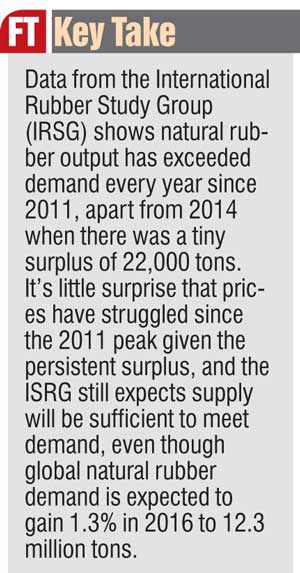Wednesday Apr 24, 2024
Wednesday Apr 24, 2024
Monday, 8 August 2016 00:00 - - {{hitsCtrl.values.hits}}
 LAUNCESTON, Australia (Reuters): There is a definite sense of deja vu in Asia’s natural rubber markets, with the latest attempt of the major producers to boost prices seemingly fizzling after a spark of success.
LAUNCESTON, Australia (Reuters): There is a definite sense of deja vu in Asia’s natural rubber markets, with the latest attempt of the major producers to boost prices seemingly fizzling after a spark of success.
The most recent effort to boost the price of the commodity mainly used for vehicle tyres came in February, with a promise from top producers Thailand, Indonesia and Malaysia to cut exports by a total of 615,000 tons for six months from March.
The possibility of the loss of about 6% of annual global natural rubber output was enough to boost prices initially, but the success was relatively short-lived.
The main rubber contract in Japan lifted from 147.1 yen ($1.40) a kilogram on 10 Feb. to a closing high of 202.2 yen by April 21, a gain of 37%.
However, it has since slipped back to close at 156.5 yen, leaving the contract down 1.5% so far this year.
The main SICOM contract in Singapore shows a similar pattern, rallying some 51% from the close on Feb. 11 to its peak so far this year of 158 U.S. cents a kg on 21 April.
But it has also since retreated, closing at 131.5 cents a kg, a level that still leaves it in positive territory so far in 2016, with a year-to-date gain of 11.5%.
If that doesn’t sound too bad, it’s worth noting that the Singapore price is still down 77% from its record in February 2011, while the Tokyo contract is 70% lower over the same period.
At best, it can be said that the effort to boost natural rubber prices by the three top Asian producers, who group themselves as the International Tripartite Rubber Council, has been a limited success.
The two main regional benchmarks didn’t manage to hold onto the initial gains, but unlike prior attempts to boost prices, this time they haven’t fallen back below where they started.
It’s worth asking why producing nations find it so hard to boost prices through restricting supply, and the answer is mainly because they don’t actually cut output by as much as they say they will, or by a large enough volume to influence the market on a sustained basis.
This can be seen by the import statistics of top buyer China, which has been increasing purchases of natural rubber despite the efforts to restrict supply.
In the first half of 2016, China’s imports of natural rubber rose 3% to 1.16 million tons.
Thailand, which was supposed to cut rubber exports by a total of 324,000 tons between March and September, saw its exports to China rising in the first half of 2016.
China imported 839,009 tons from its top supplier Thailand in the January to June period, a gain of 6.4% over the same period in 2015.
Imports from number two and three suppliers Malaysia and Indonesia did decline by 1.1% and 6% respectively, but these modest drops were nowhere near enough to offset the increase from Thailand.
DISCIPLINE NEEDED
It’s clear that if rubber producers are going to alter the supply-demand balance in their favour, they will have to exercise more discipline.
An effort by 10 major rubber companies in Asia last year to lift prices and try to change the pricing mechanism appears to have stalled because producers battled to maintain supply discipline over an extended time period.
Similarly, efforts by governments to restrict supply to the market by buying from farmers and stockpiling, as tried by Thailand, also didn’t work as it merely provided an incentive for farmers to keep producing even though prices weren’t high enough to cover costs.
The same criticism can be levelled at state schemes to support farmers during periods of low prices, which make little sense from an economic perspective even if they are deemed essential for social stability.
Data from the International Rubber Study Group (IRSG) shows natural rubber output has exceeded demand every year since 2011, apart from 2014 when there was a tiny surplus of 22,000 tons.
It’s little surprise that prices have struggled since the 2011 peak given the persistent surplus, and the ISRG still expects supply will be sufficient to meet demand, even though global natural rubber demand is expected to gain 1.3% in 2016 to 12.3 million tons.
Natural rubber prices are likely to continue to tread water at best in the absence of sustained supply discipline and modest demand growth.